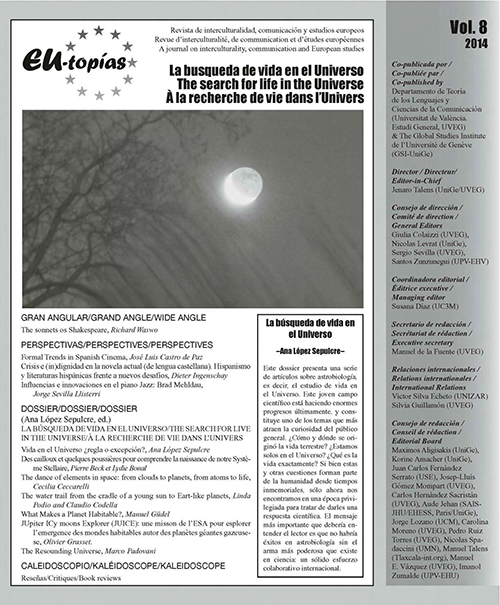Vida en el Universo ¿Regla o excepción?
DOI:
https://doi.org/10.7203/eutopias.0.18774Keywords:
Astronomy, biology, music, science, art Abstract
Abstract
Our planet, Earth, is the only place currently known to harbour life. Whether life as we know it exists or not elsewhere is a subject that has fascinated humankind for centuries. On the scientific side, providing an answer to this question requires a huge collaborative effort from many different fields of research that include astronomy, physics, chemistry, biology, geology, and even philosophy of science. While far from being exhaustive, this dossier presents different pieces of the huge puzzle known as astrobiology, from the exploration of our Solar System to that of the so-called exoplanets (planets orbiting around other stars). Special attention is given to highlight the crucial role of European research to achieve the level of understanding we now have on the matter, including a whole article devoted to the promising European Space Agency (ESA) space mission JUICE as an illustrative example. Finally, the last article dives into more imaginative areas by describing the connection between music and the exploration of the cosmos, showing how astronomy and arts very frequently go hand in hand.
 Downloads
Downloads
 References
References
BRUNO, Giordano (1584), De l’infinito universe et mondi. Epistola Proemiale, Venecia
CLEAVES, H.J., CHALMERS, J.H., LAZCANO, A., MILLER, S.L., BADA, J.L. (2008), “A reassessment of prebiotic organic synthesis in neutral planetary atmospheres”, Origins of Life and Evolution of Biospheres, 38, pp. 105-115.
HOGBEN, Lancelot (1930), “The nature of living matter”, London: Kegan Paul, Trench, Trubner. HUET, Sylvestre (2013), “De l’inerte au vivant. Une enquête scintifique et philosophique”, Paris: La ville brûle.
LIN, Henry W., GONZÁLEZ ABAD, Gonzalo, LOEB, Abraham (2014), accepted in Astrophysical Journal [arXiv: 1406.3025v2]
MC KAY, David S., GIBSON Jr, Everett K, THOMASKEPRTA, Kathie L. et al. (1996), “Search for past life on Mars: Possible relic biogenic activity in Martian meteorite ALH84001”, Science, 273, pp. 924-930.
MILLER, Stanley L. (1953), “Production of amino acids under possible Earth conditions”, Science, 117, pp. 528-529.
MILLER, Stanley L., UREY, Harold C. (1959), “Organic compound synthesis on the primitive Earth”, Science, 130, pp. 245-251
MAYOR, Michel, QUELOZ, Didier (1995), “A Jupitermass companion to a solar-type star” Nature, 378, pp. 355-359.
SCHRÖDINGER, Erwin (1944), “What is life? The physical aspect of the living cell”, Cambridge: Cambridge University Press.
Downloads
Published
How to Cite
-
Abstract860
-
PDF (Español)132
Issue
Section
License
![]()
The authors conserve the copyright. All content published in EU-topías. Journal of interculturality, Communication, and European Studies are subject to the license Creative Commons Attribution-NonCommercial-ShareAlike 4.0 license. The full text of the license can be found at <http://creativecommons.org/licenses/by-nc-sa/4.0>
They may be copied, used, disseminated, transmitted and publicly displayed, provided that:
- The authorship and original source of the publication is cited (journal, publisher and URL of the work).
- They are not used for commercial purposes.
- The existence and specifications of this license of use are mentioned.
It is the responsibility of the authors to obtain the necessary permissions for images that are subject to copyright.



